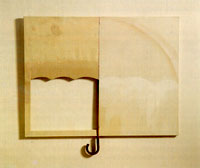



|
ALEKSANDAR DJURIC, painter (Belgrade, 1953) One of the most complex painters in the modern Serbian art, Aleksandar Djuric has based his artistic procede on the idea of an integral picture. This idea of the integral has for Djuric two substantial and meaningful layers, two dimensions which form an entity: to make an integral painting which is, as the author says, at the same time, the illusion ratified reality and a metaphor. And than - make it a part of an overall human reality. He has started as a follower of restoration of a special painting technique (practiced also by the greatest masters of the European mederna) - college urged by researches and results of the great Serbian painter Ivan Tabakovic. The first exhibition of collages in 1980 offered a new dimension both in the technical - technological and in substantial layer of the deed, by putting into new relations certain visual and meaningful entities (photographs), most frequently by combining "messages" from different times, which resulted in a deep synthetic, up - to - date expression. The next exhibition of collages, three years later, speaks already in its title - the simultaneous eye - about the idea and the intention of the author. When the exhibition "The paintersz workshop" appeared in 1985, Djuric was already a formed creative personality characterized by an equilibrium of the rational and emotional knowledge, intuition and constructional skull. On the conceptual - aesthetic plan, Djuric tries, as he says, to synthesize experiences of modern art which had during past years "one common idea" and that is the destruction of the object. I introduce again the real object into the picture and leave it as it is in reality". With such a concept (the complex relation of the painting toward the reality of art and reality of life), Djuric separates from the basic principles of pop art and approaches to post conceptual practice. The final akt of making the painting takes place in a spectator who leaves himself to its rational and to its visual-poetic nature. Everyone of his exhibitions was a precious proposal for a new seeing (a new defining) of some of the actual artistic ideas of the time. Actuality of his work, however, is not based on parallelism of the existence of some actual trends: his thought is directed to the question of the overall fate of modern art and its relation toward the most vital problems of the human existence. |




